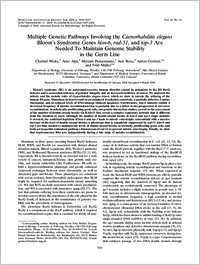Multiple genetic pathways involving the Caenorhabditis elegans Bloom's syndrome genes him-6, rad-51, and top-3 are needed to maintain genome stability in the germ line
Université de Fribourg
- Wicky, Chantal Department of Biology, University of Fribourg, Switzerland
- Alpi, Arno Max Planck Institute for Biochemistry, Martinsried, Germany
- Passannante, Myriam Department of Biology, University of Fribourg, Switzerland
- Rose, Ann Department of Medical Genetics, University of British Columbia, Vancouver, Canada
- Gartner, Anton Max Planck Institute for Biochemistry, Martinsried, Germany
- Müller, Fritz Department of Biology, University of Fribourg, Switzerland
-
2004
Published in:
- Molecular and Cellular Biology. - 2004, vol. 24, no. 11, p. 5016-5027
English
Bloom's syndrome (BS) is an autosomal-recessive human disorder caused by mutations in the BS RecQ helicase and is associated with loss of genomic integrity and an increased incidence of cancer. We analyzed the mitotic and the meiotic roles of Caenorhabditis elegans him-6, which we show to encode the ortholog of the human BS gene. Mutations in him-6 result in an enhanced irradiation sensitivity, a partially defective S-phase checkpoint, and in reduced levels of DNA-damage induced apoptosis. Furthermore, him-6 mutants exhibit a decreased frequency of meiotic recombination that is probably due to a defect in the progression of crossover recombination. In mitotically proliferating germ cells, our genetic interaction studies, as well as the assessment of the number of double-strand breaks via RAD-51 foci, reveal a complex regulatory network that is different from the situation in yeast. Although the number of double-strand breaks in him-6 and top-3 single mutants is elevated, the combined depletion of him-6 and top-3 leads to mitotic catastrophe concomitant with a massive increase in the level of double-strand breaks, a phenotype that is completely suppressed by rad-51. him-6 and top-3 are thus needed to maintain low levels of double-strand breaks in normally proliferating germ cells, and both act in partial redundant pathways downstream of rad-51 to prevent mitotic catastrophy. Finally, we show that topoisomerase III{alpha} acts independently during a late stage of meiotic recombination.
- Faculty
- Faculté des sciences et de médecine
- Department
- Département de Biologie
- Language
-
- English
- Classification
- Biological sciences
- License
-
License undefined
- Identifiers
-
- RERO DOC 4142
- DOI 10.1128/MCB.24.11.5016-5027.2004
- Persistent URL
- https://folia.unifr.ch/global/documents/299550
Statistics
Document views: 192
File downloads:
- Texte intégral: 266
